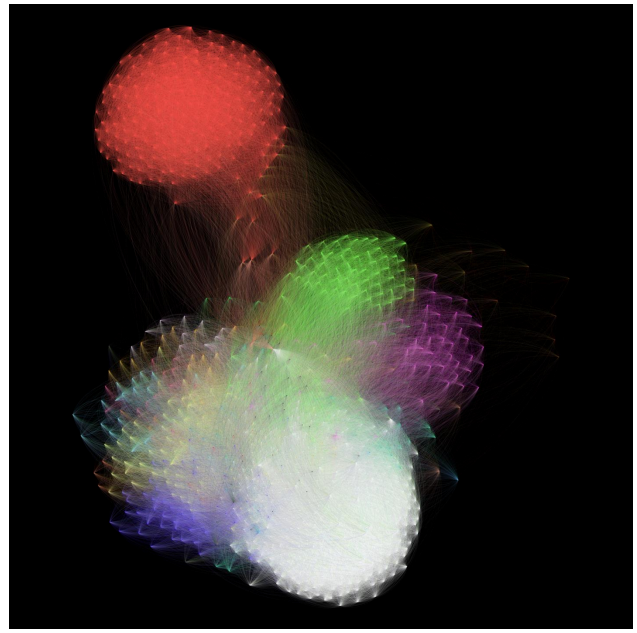How the Great Firewall of China Shapes Chinese Surfing Habits
Early in 2010, the U.S. secretary of state, Hillary Clinton, warned against Internet censorship and the possibility that it could create “a new information curtain” similar in many ways to the Iron Curtain that separated East and West during the Cold War.

Her remarks were widely interpreted as a criticism of Chinese censorship of the Internet, which prevents people in mainland China from accessing many sites abroad, such as Wikipedia, Facebook, YouTube, and many news sites. It also censors internal content that is politically unpalatable or sexually explicit.
It’s easy to imagine that this so-called Great Firewall of China must create a significant fault line in the structure of the global Internet. But today Harsh Taneja and Angela Xiao Wu at Northwestern University in Evanston, Illinois, argue otherwise.
They say that Chinese websites are clustered in a similar way to others that share a common language and geographic connections. What’s more, they argue that the Chinese cluster is no more isolated than other clusters.
The method that these guys used is relatively straightforward. They analysed the traffic to the world’s 1,000 most popular websites and worked out how audience viewing habits connect the sites to each other. In particular, they assumed that sites with a greater than average shared readership were more closely connected.
This approach gave them a database showing the strength of the connection between each of the 1,000 websites and the other 999. They say the results cluster into 18 communities according to language and geography. These are colour-coded in the diagram above: the English cluster in white is the largest followed by the Chinese cluster in red, the Japanese cluster in green, and the French in yellow and so on.
Taneja and Xiao Wu argue that this shows that the Chinese cluster is no more isolated than other culturally defined markets. And their conclusion is that online behaviour must be more strongly influenced by cultural factors than by censorship.
They say this conclusion is backed up by studies of the way information was consumed before and after the collapse of communism. For example, that the number of English book translations in Eastern Europe before and after the collapse of communism suggests that audience preference played a more important role than state censorshipin shaping demand.
But a closer look at this new work suggests that the Chinese cluster may not be as ordinary as Taneja and Xiao Wu suggest. While most websites fall squarely within a certain community, a small proportion act as bridges between one cluster and another. These make an interesting group.
The biggest bridging site between the Chinese cluster and the rest of the world is Alibaba.com, a business-to-business trading platform based in mainland China. However, the second-biggest bridging site is the Chinese-language version of Wikipedia.
That’s strange. In other clusters, Wikipedia plays a central role in each culturally defined market. You only have to look at the significance of Wikipedia in the results of any Google.com search to see how central it is in the English cluster, for example. This difference can only be explained by Chinese censorship of Wikipedia and the lack of local Chinese input that it leads to.
What’s more, the next most popular bridging sites are in Taiwan and Hong Kong. Although these are written in Chinese and clearly accessed by many Chinese-speaking people, they are blocked by the Great Firewall of China.
So how do these sites come to be so prominent in the Chinese cluster? The answer is almost certainly that they are largely accessed by the Chinese diaspora in other parts of the world.
And herein lies the biggest problem with the study by Taneja and Xiao Wu—it fails to take proper account of the behaviour of Chinese-speaking people who are outside of the Great Firewall of China but able to access content within it. It is easy to imagine that this relatively small group acts as the glue that links the Chinese cluster to the rest of the world.
If that’s the case, then the cultural fault lines created by the Great Firewall are hidden in this data.
It may well be that cultural factors are an important influence on people’s surfing habits, possibly the most important influence. But the argument that censorship is somehow less significant because of this is insidious and dangerous. On this matter, Hillary Clinton was correct.
Ref: arxiv.org/abs/1305.3311: How Does the Great Firewall of China Affect Online User Behavior? Isolated “Internets” as Culturally Defined Markets on the WWW
Keep Reading
Most Popular
Large language models can do jaw-dropping things. But nobody knows exactly why.
And that's a problem. Figuring it out is one of the biggest scientific puzzles of our time and a crucial step towards controlling more powerful future models.
The problem with plug-in hybrids? Their drivers.
Plug-in hybrids are often sold as a transition to EVs, but new data from Europe shows we’re still underestimating the emissions they produce.
Google DeepMind’s new generative model makes Super Mario–like games from scratch
Genie learns how to control games by watching hours and hours of video. It could help train next-gen robots too.
How scientists traced a mysterious covid case back to six toilets
When wastewater surveillance turns into a hunt for a single infected individual, the ethics get tricky.
Stay connected
Get the latest updates from
MIT Technology Review
Discover special offers, top stories, upcoming events, and more.